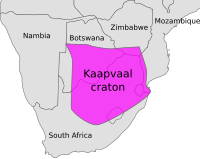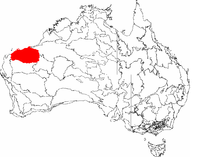Vaalbara is a hypothetical Archean supercontinent consisting of the Kaapvaal Craton (now in eastern South Africa) and the Pilbara Craton (now in north-western Western Australia). E. S. Cheney derived the name from the last four letters of each craton's name. The two cratons consist of continental crust dating from 2.7 to 3.6 Ga, which would make Vaalbara one of Earth's earliest supercontinents.[1]
 A reconstruction of Vaalbara[citation needed] | |
| Historical continent | |
|---|---|
| Formed | 3.6 Ga |
| Type | Supercontinent |
| Today part of | |
Existence and lifespan
editThere has been some debate as to when and even if Vaalbara existed. An Archaean–Palaeoproterozoic (2.8–2.1 Ga) link between South Africa and Western Australia was first proposed by A. Button in 1976. He found a wide range of similarities between the Transvaal Basin in South Africa and the Hamersley Basin in Australia. Button, however, placed Madagascar between Africa and Australia and concluded that Gondwana must have had a long stable tectonic history.[2] Similarly, in the reconstruction of Rogers 1993, 1996 the oldest continent is Ur. In Rogers' reconstructions, however, Kaapvaal and Pilbara are placed far apart already in their Gondwana configuration, a reconstruction contradicted by later orogenic events and incompatible with the Vaalbara hypothesis.[3]
Cheney 1996, nevertheless, found a three-fold stratigraphic similarity and proposed that the two cratons once formed a continent which he named Vaalbara. This model is supported by the palaeomagnetic data of Zegers, de Wit & White 1998.[4] Reconstructions of the palaeolatitudes of the two cratons at 2.78–2.77 Ga are ambiguous however. In the reconstruction of Wingate 1998 they fail to overlap, but they do in more recent reconstructions, for example Strik et al. 2003.[5]
Other scientists dispute the existence of Vaalbara and explain similarities between the two cratons as the product of global processes. They point, for example, to thick volcanic deposits on other cratons such as Amazonia, São Francisco, and Karnataka.[6]
Zimgarn, another proposed supercraton composed of the Zimbabwe and Yilgarn cratons at 2.41 Ga, is distinct from Vaalbara. Zimgarn should have disintegrated around 2.1–2.0 Ga to reassemble as the Kalahari and West Australian (Yilgarn and Pilbara) cratons around 1.95–1.8 Ga.[7]
The Archaean–Palaeoproterozoic Grunehogna Craton in Queen Maud Land, East Antarctica, formed the eastern part of the Kalahari Craton for at least a billion years. Grunehogna collided with the rest of East Antarctica during the Mesoproterozoic assembly of the supercontinent Rodinia and the Grenville orogeny. The Neoproterozoic Pan-African orogeny and the assembly of Gondwana/Pannotia produced large shear zones between Grunehogna and Kalahari. During the Jurassic break-up of Gondwana, these shear zones finally separated Grunehogna and the rest of Antarctica from Africa.[8] In the Annandags Peaks in Antarctica, the only exposed parts of Grunehogna, detrital zircons from several crustal sources have been dated to 3.9–3.0 Ga suggesting intracrustal recycling was an important part in the formation of the first cratons.[9]
The Kaapvaal craton is marked by dramatic events such as the intrusion of the Bushveld Complex (2.045 Ga) and the Vredefort impact event (2.025 Ga), and no traces of these events have been found in the Pilbara craton, clearly indicating that the two cratons were separated before 2.05 Ga.[10] Furthermore, geochronological and palaeomagnetic evidence show that the two cratons had a rotational 30° latitudinal separation in the time period of 2.78–2.77 Ga, which indicates they were no longer joined after c. 2.8 billion years ago.[11]
Vaalbara thus remained stable for 1–0.4 Ga and hence had a life span similar to that of later supercontinents such as Gondwana and Rodinia.[10] Some palaeomagnetic reconstructions suggest a Palaeoarchaean proto-Vaalbara is possible, although the existence of this 3.6–3.2 Ga continent cannot be proven.[12]
Evidence
editSouth Africa's Kaapvaal craton and Western Australia's Pilbara craton have similar early Precambrian cover sequences.[13] Kaapvaal's Barberton granite-greenstone terrane and Pilbara's eastern block show evidence of four large meteorite impacts between 3.2 and 3.5 billion years ago.[14] Similar greenstone belts are found at the margins of the Superior Craton of Canada.[15]
The high temperatures created by the impacts' forces fused sediments into small glassy spherules.[16] Spherules of 3.5 billion years old exist in South Africa, and spherules of a similar age have been found in Western Australia;[16] they are the oldest-known terrestrial impact products.[17] The spherules resemble the glassy chondrules (rounded granules) in carbonaceous chondrites, which are found in carbon-rich meteorites and lunar soils.[16]
Remarkably similar lithostratigraphic and chronostratigraphic structural sequences between these two cratons have been noted for the period between 3.5 and 2.7 Ga.[18] Paleomagnetic data from two ultramafic complexes in the cratons showed that at 3.87 Ga the two cratons could have been part of the same supercontinent.[18] Both the Pilbara and Kaapvaal cratons show extensional faults which were active about 3.47 Ga during felsic volcanism and coeval with the impact layers.[18]
Origin of life
editThe Pilbara and Kaapvaal cratons contain well-preserved Archaean microfossils. Drilling has revealed traces of microbial life and photosynthesis from the Archaean in both Africa and Australia.[19] The oldest widely accepted evidence of photosynthesis by early life forms is molecular fossils found in 2.7 Ga-old shales in the Pilbara Craton. These fossils have been interpreted as traces of eukaryotes and cyanobacteria, though some scientists argue that these biomarkers must have entered these rocks later and date the fossils to 2.15–1.68 Ga.[20] This later time span agrees with estimates based on molecular clocks which dates the eukaryote last common ancestor at 1.8–1.7 Ga. If the Pilbara fossils are traces of early eukaryotes, they could represent groups that went extinct before modern groups emerged.[21]
See also
editNotes
edit- ^ Zegers, de Wit & White 1998, Abstract
- ^ Button 1976, Synopsis, p. 262; for Button's reconstruction see fig. 20f, p. 286
- ^ de Kock, Evans & Beukes 2009, Introduction, pp. 145–146
- ^ Zhao et al. 2004, pp. 96–98
- ^ Strik et al. 2003, Implications for the Vaalbara Hypothesis, pp. 19–20, fig. 11
- ^ Nelson, Trendall & Altermann 1999, Independent development of the Pilbara and Kaapvaal cratons — implications, pp. 186–187
- ^ Smirnov et al. 2013, Abstract
- ^ Marschall et al. 2010, Geology of the Grunehogna Craton, pp. 2278–2280
- ^ Marschall et al. 2010, Conclusions, p. 2298
- ^ a b Zegers, de Wit & White 1998, Discussion, pp. 255–257
- ^ Wingate 1998, Abstract
- ^ Biggin et al. 2011, p. 326
- ^ de Kock 2008, p. VII
- ^ Byerly et al. 2002, Abstract
- ^ Nitescu, Cruden & Bailey 2006, Fig. 1, p. 2
- ^ a b c Erickson 1993, p. 27
- ^ Lowe & Byerly 1986, p. 83
- ^ a b c Zegers & Ocampo 2003
- ^ Philippot et al. 2009, Abstract; Waldbauer et al. 2009, Conclusions, p. 45
- ^ Rasmussen et al. 2008, p. 1101
- ^ Parfrey et al. 2011, Discussion, p. 13626.
References
edit- Biggin, A. J.; de Wit, M. J.; Langereis, C. G.; Zegers, T. E.; Voûte, S.; Dekkers, M. J.; Drost, K. (2011). "Palaeomagnetism of Archaean rocks of the Onverwacht Group, Barberton Greenstone Belt (southern Africa): Evidence for a stable and potentially reversing geomagnetic field at ca. 3.5 Ga". Earth and Planetary Science Letters. 302 (3): 314–328. Bibcode:2011E&PSL.302..314B. doi:10.1016/j.epsl.2010.12.024. Retrieved 12 September 2016.
- Button, A. (1976). "Transvaal and Hamersley basins—review of basin development and mineral deposits" (PDF). Mineral Science Engineering. 8 (4): 262–293. OCLC 13791945. Retrieved 12 September 2016.
- Byerly, G. R.; Lowe, D. R.; Wooden, J. L.; Xie, X. (2002). "An Archean Impact Layer from the Pilbara and Kaapvaal Cratons". Science. 297 (5585): 1325–1327. Bibcode:2002Sci...297.1325B. doi:10.1126/science.1073934. PMID 12193781. S2CID 23112906. Retrieved 12 September 2016.
- Cheney, E. S. (1996). "Sequence stratigraphy and plate tectonic significance of the Transvaal succession of southern Africa and its equivalent in Western Australia". Precambrian Research. 79 (1–2): 3–24. Bibcode:1996PreR...79....3C. doi:10.1016/0301-9268(95)00085-2.
- de Kock, M. O. (2008). Paleomagnetism of Selected Neoarchean-Paleoproterozoic Cover Sequences on the Kaapvaal Craton and Implications for Vaalbara (Ph.D.). University of Johannesburg. Retrieved 12 September 2016.
- de Kock, M. O.; Evans, D. A. D.; Beukes, N. J. (2009). "Validating the existence of Vaalbara in the Neoarchean". Precambrian Research. 174 (1): 145–154. Bibcode:2009PreR..174..145D. doi:10.1016/j.precamres.2009.07.002. Retrieved 12 September 2016.
- Erickson, Jon (1993). Craters, Caverns and Canyons – Delving Beneath the Earth's Surface. Facts on File. ISBN 978-0-8160-2590-9.
- Lowe, D. R.; Byerly, G. R. (1986). "Early Archean silicate spherules of probable impact origin, South Africa and Western Australia". Geology. 14 (1): 83–86. Bibcode:1986Geo....14...83L. doi:10.1130/0091-7613(1986)14<83:EASSOP>2.0.CO;2.
- Marschall, H. R.; Hawkesworth, C. J.; Storey, C. D.; Dhuime, B.; Leat, P. T.; Meyer, H. P.; Tamm-Buckle, S. (2010). "The Annandagstoppane Granite, East Antarctica: evidence for Archaean intracrustal recycling in the Kaapvaal–Grunehogna Craton from zircon O and Hf isotopes" (PDF). Journal of Petrology. 51 (11): 2277–2301. Bibcode:2010JPet...51.2277M. doi:10.1093/petrology/egq057. Retrieved 14 May 2016.
- Nelson, D. R.; Trendall, A. F.; Altermann, W. (1999). "Chronological correlations between the Pilbara and Kaapvaal cratons" (PDF). Precambrian Research. 97 (3): 165–189. Bibcode:1999PreR...97..165N. doi:10.1016/S0301-9268(99)00031-5. Retrieved 17 April 2016.
- Nitescu, B.; Cruden, A. R.; Bailey, R. C. (2006). "Crustal structure and implications for the tectonic evolution of the Archean Western Superior craton from forward and inverse gravity modeling". Tectonics. 25 (TC1009): n/a. Bibcode:2006Tecto..25.1009N. doi:10.1029/2004TC001717.
- Parfrey, Laura Wegener; Lahr, Daniel J. G.; Knoll, Andrew H.; Katz, Laura A. (August 16, 2011). "Estimating the timing of early eukaryotic diversification with multigene molecular clocks". Proceedings of the National Academy of Sciences of the United States of America. 108 (33): 13624–13629. Bibcode:2011PNAS..10813624P. doi:10.1073/pnas.1110633108. PMC 3158185. PMID 21810989.
- Philippot, P.; Van Kranendonk, M.; Van Zuilen, M.; Lepot, K.; Rividi, N.; Teitler, Y.; Thomazo, C.; Blanc-Valleron, M.-M.; Rouchy, J.-M.; Grosch, E.; de Wit, M. (2009). "Early traces of life investigations in drilling Archean hydrothermal and sedimentary rocks of the Pilbara Craton, Western Australia and Barberton greenstone belt, South Africa". Comptes Rendus Palevol. 8 (7): 649–663. Bibcode:2009CRPal...8..649P. doi:10.1016/j.crpv.2009.06.006. Retrieved 12 September 2016.
- Rasmussen, B.; Fletcher, I. R.; Brocks, J. J.; Kilburn, M. R. (2008). "Reassessing the first appearance of eukaryotes and cyanobacteria" (PDF). Nature. 455 (7216): 1101–1104. Bibcode:2008Natur.455.1101R. doi:10.1038/nature07381. PMID 18948954. S2CID 4372071. Retrieved 24 April 2016.
- Rogers, J. J. (1993). "India and Ur". Geological Society of India. 42 (3): 217–222. Retrieved 17 March 2016.
- Rogers, J. J. W. (1996). "A history of continents in the past three billion years". Journal of Geology. 104 (1): 91–107, Chicago. Bibcode:1996JG....104...91R. doi:10.1086/629803. JSTOR 30068065. S2CID 128776432.
- Smirnov, A. V.; Evans, D. A.; Ernst, R. E.; Söderlund, U.; Li, Z. X. (2013). "Trading partners: tectonic ancestry of southern Africa and western Australia, in Archean supercratons Vaalbara and Zimgarn" (PDF). Precambrian Research. 224: 11–22. Bibcode:2013PreR..224...11S. doi:10.1016/j.precamres.2012.09.020. Retrieved 26 March 2016.
- Strik, G.; Blake, T. S.; Zegers, T. E.; White, S. H.; Langereis, C. G. (2003). "Palaeomagnetism of flood basalts in the Pilbara Craton, Western Australia: Late Archaean continental drift and the oldest known reversal of the geomagnetic field". Journal of Geophysical Research: Solid Earth. 108 (B12): 2551. Bibcode:2003JGRB..108.2551S. doi:10.1029/2003jb002475. Retrieved 12 September 2016.
- Waldbauer, J. R.; Sherman, L. S.; Sumner, D. Y.; Summons, R. E. (2009). "Late Archean molecular fossils from the Transvaal Supergroup record the antiquity of microbial diversity and aerobiosis". Precambrian Research. 169 (1): 28–47. Bibcode:2009PreR..169...28W. doi:10.1016/j.precamres.2008.10.011. Archived from the original on June 4, 2016. Retrieved 24 April 2016.
- Wingate, M. T. D. (1998). "A palaeomagnetic test of the Kaapvaal-Pilbara (Vaalbara) connection at 2.78 Ga". South African Journal of Geology. 101 (4): 257–274. Retrieved 12 September 2016.
- Zegers, T. E.; de Wit, M. J.; White, S. H. (1998). "Vaalbara, Earth's oldest assembled continent? A combined. structural, geochronological, and palaeomagnetic test" (PDF). Terra Nova. 10 (5): 250–259. Bibcode:1998TeNov..10..250Z. CiteSeerX 10.1.1.566.6728. doi:10.1046/j.1365-3121.1998.00199.x. S2CID 52261989. Retrieved 17 April 2016.
- Zegers, T. E.; Ocampo, A. (2003). Vaalbara and Tectonic Effects of a Mega Impact in the Early Archean 3470 Ma. Third International Conference on Large Meteorite Impacts. Nordlingen, Germany. Retrieved 12 September 2016.
- Zhao, G.; Sun, M.; Wilde, S. A.; Li, S. (2004). "A Paleo-Mesoproterozoic supercontinent: assembly, growth and breakup". Earth-Science Reviews. 67 (1): 91–123. Bibcode:2004ESRv...67...91Z. doi:10.1016/j.earscirev.2004.02.003. Retrieved 12 September 2016.

